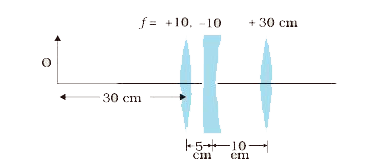Text Solution
Verified by Experts
|
Topper's Solved these Questions
RAY OPTICS AND OPTICAL INSTRUMENTS
NCERT GUJARATI|Exercise EXERCISES|40 VideosView PlaylistNUCLEI
NCERT GUJARATI|Exercise ADDITIONAL EXERCISES|9 VideosView PlaylistSEMICONDUCTOR ELECTRONICS: MATERIALS, DEVICES AND SIMPLE CIRCUITS
NCERT GUJARATI|Exercise ADDITIONAL EXERCISES|8 VideosView Playlist
Similar Questions
Explore conceptually related problems
NCERT GUJARATI-RAY OPTICS AND OPTICAL INSTRUMENTS-EXERCISES
- Find the position of the image formed by the lens combination given in...
04:24
|
Playing Now - A small candle, 2.5 cm in size is placed at 27 cm in front of a concav...
05:54
|
Play - A 4.5 cm needle is placed 12 cm away from a convex mirror of focal len...
04:46
|
Play - A tank is filled with water to a height of 12.5 cm. The apparent depth...
03:14
|
Play - Figures 9.31(a) and (b) show refraction of a ray in air incident at 60...
05:22
|
Play - A small bulb is placed at the bottom of a tank containing water to a d...
05:13
|
Play - A prism is made of glass of unknown refractive index. A parallel beam ...
05:26
|
Play - Double-convex lenses are to be manufactured from a glass of refractive...
02:02
|
Play - A beam of light converges at a point P. Now a lens is placed in the pa...
03:31
|
Play - An object of size 3.0cm is placed 14cm in front of a concave lens of f...
04:37
|
Play - What is the focal length of a convex lens of focal length 30cm in cont...
02:25
|
Play - A compound microscope consists of an objective lens of focal length 2....
07:29
|
Play - A person with a normal near point (25 cm) using a compound microscope ...
05:53
|
Play - A small telescope has an objective lens of focal length 144cm and an e...
01:13
|
Play - (a) A giant refracting telescope at an observatory has an objective le...
04:21
|
Play - Use the mirror equation to deduce that: (a) an object placed between...
04:11
|
Play - A small pin fixed on a table top is viewed from above from a distance ...
04:25
|
Play - (a) Figure 9.32 shows a cross-section of a 'light pipe' made of a glas...
06:52
|
Play - Answer the following questions: (a) You have learnt that plane and c...
04:30
|
Play - Answer the following questions: (b) A virtual image, we always say, ...
01:59
|
Play - Answer the following questions: (c) A diver under water, looks obliq...
01:46
|
Play
